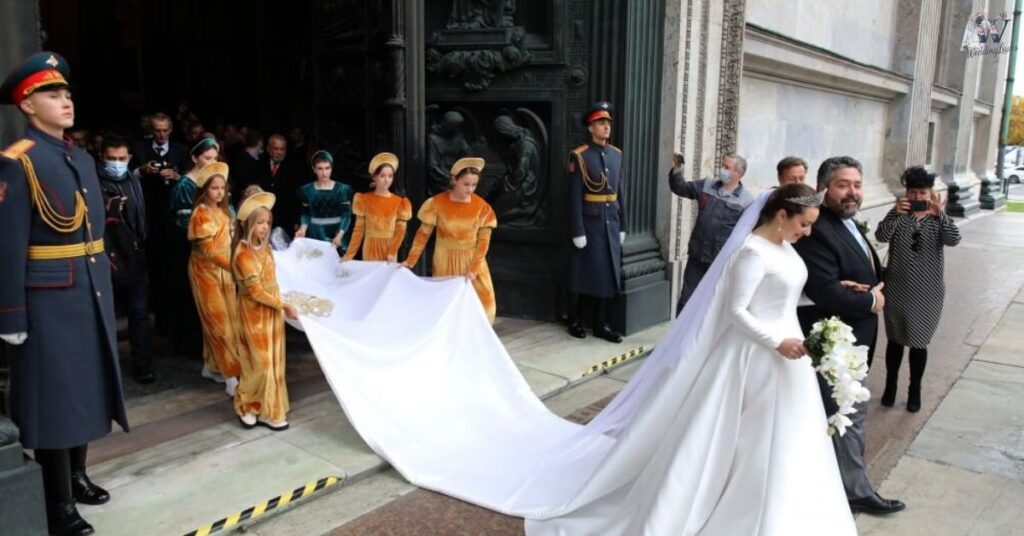The Romanov wedding was one of the grandest events in Russia’s royal history. This wedding joined Tsar Nicholas II, the last Emperor of Russia, and Alexandra Feodorovna, a German princess who became his beloved wife. Held on November 26, 1894, it symbolized the peak of Imperial Russia’s glory. A royal wedding like this is more than just a marriage—it connects powerful families, shows off traditions, and unites people in celebration.
The ceremony was filled with ancient Russian rituals, lavish outfits, and luxurious feasts. But while it was a beautiful moment, it also marked the beginning of a troubled era for Russia.
A Match Made in History
Nicholas II, the last Emperor of Russia, fell in love with Alexandra Feodorovna, a German princess, at first sight. They met in 1884 during the wedding of Alexandra’s sister to Nicholas’s uncle. However, their path to marriage wasn’t easy. Alexandra was hesitant at first because of her strong Lutheran faith, which didn’t align with the Russian Orthodox Church.
Despite the challenges, Nicholas stayed committed to marrying her. Over time, Alexandra converted to Orthodoxy and took the name Alexandra Feodorovna. Their union wasn’t just about love—it also tied two powerful royal families, the Romanovs and the British House of Windsor, through Queen Victoria’s bloodline.
The Grand Wedding Ceremony
The wedding of Tsar Nicholas II and Alexandra Feodorovna took place on November 26, 1894, at the Grand Church of the Winter Palace in St. Petersburg. The church was decorated with gold accents and icons, reflecting the deep traditions of the Russian Orthodox Church. Alexandra wore a stunning silver gown, embroidered with jewels, pearls, and delicate patterns. She also wore the Romanov nuptial crown, a dazzling masterpiece of Russian jewelry.
The ceremony followed Orthodox traditions, including the crowning ritual, symbolizing the couple’s new role as rulers of their household. Royals from across Europe attended, making it a significant international event. Nicholas and Alexandra exchanged rings to show their eternal bond. After the church service, the couple was cheered by crowds celebrating outside the palace. The event captured both the opulence of the Romanov dynasty and the devotion between the bride and groom.
The Reception: A Feast of Imperial Proportions
After the wedding ceremony, the celebration continued with a grand reception at the Winter Palace. The palace was decorated with stunning flowers and fine decorations, creating a magical atmosphere. Guests enjoyed a wide variety of dishes, including caviar, game meat, and other luxurious foods. The finest champagne flowed freely, adding to the festive spirit.
The reception lasted for several days, filled with balls, banquets, and entertainment. Royal families from across Europe attended, making the event even more special. It was not just a feast but a display of Russia’s wealth and cultural pride. The streets of St. Petersburg came alive with joy, as people celebrated their new emperor and empress. This reception symbolized the height of Imperial Russia’s splendor, just before the challenges that lay ahead for the Romanov dynasty.
The Legacy of the Romanov Wedding

The wedding of Tsar Nicholas II and Alexandra Feodorovna was a dazzling event, but it also signaled the start of difficult times for Russia. Though their love was genuine, the couple’s bond isolated them from the Russian nobility and public. Alexandra’s influence over Nicholas, and her connection with the controversial mystic Rasputin, caused distrust and tensions within the royal court.
Nicholas’s reign faced political unrest, war, and growing dissatisfaction among the people. The Romanov dynasty fell during the Russian Revolution of 1917, ending centuries of imperial rule. In hindsight, their wedding is seen as a final moment of royal splendor before the empire’s collapse. Today, it stands as a symbol of both romance and tragedy—reminding us of how even the grandest celebrations can precede dramatic change. The legacy of their union continues to captivate historians and romantics alike, offering a glimpse into the fading world of Imperial Russia.
Also read this: Remembering the Iconic Wedding of Whitney Houston and Bobby Brown
Symbolism and Traditions of the Romanov Wedding
The Romanov wedding was rich in traditions, reflecting the customs of the Russian Orthodox Church. One important ritual was the crowning ceremony, where Nicholas and Alexandra wore crowns, symbolizing them as rulers of their household. The exchange of rings represented eternal love and unity. The bride also had to walk around the altar with her groom three times, showing their shared spiritual journey.
Every detail in the wedding had meaning. Alexandra’s wedding gown, made of silver cloth with pearls and diamonds, symbolized purity and wealth. The nuptial crown, decorated with jewels, reflected the royal family’s power and status. The grand church setting at the Winter Palace highlighted the connection between faith and royalty. These ancient traditions were not just beautiful; they showed how deeply the couple’s union was tied to Russian history, faith, and family.
| Name/Title | Facts/Figures |
| Tsar Nicholas II | Last Emperor of Russia; married Alexandra Feodorovna on November 26, 1894. |
| Alexandra Feodorovna | Born Princess Alix of Hesse; converted to Orthodoxy before marriage. |
| Wedding Date | November 26, 1894 |
| Venue | Grand Church of the Winter Palace, St. Petersburg |
| Attendees | Several hundred guests, including various royal families. |
| Notable Guests | Michael, Duke of Württemberg; Duke of Anjou Louis Alfonso; Simeon II of Bulgaria. |
| Ceremony Features | Crowning ceremony, exchange of rings, traditional Orthodox rites. |
| Wedding Dress | Silver cloth gown adorned with diamonds and pearls. |
| Reception | Lavish feast with caviar, game, and champagne; lasted several days. |
| Historical Significance | Symbolized the peak of Imperial Russia and foreshadowed the Romanov dynasty’s decline. |
Final words
The Romanov wedding was a dazzling display of love, tradition, and royal power. It brought together two important dynasties and showcased the splendor of Imperial Russia. Every part of the ceremony, from the crowns to the grand feast, was full of meaning and history.
However, this beautiful celebration also marked the beginning of a difficult time for the Russian Empire. While Nicholas and Alexandra’s love was strong, their rule faced many challenges, leading to the downfall of the Romanov dynasty. The wedding remains a powerful reminder of a world filled with both glory and tragedy.
Frequently asked questions
Who attended the Romanov wedding?
The ceremony was attended by several hundred guests invited by the Russian Imperial House. Among them were representatives from various royal families, including Michael, Duke of Württemberg, a member of the Spanish royal family, Duke of Anjou Louis Alfonso, and Simeon II, the last Tsar of Bulgaria from the Saxe-Coburg-Gotha dynasty.
Do any Romanovs still exist?
Yes, many descendants of the Romanov family are alive today. However, the direct line of Nicholas II was executed during the Russian Revolution, and no Romanov currently holds any real power in Russia.
Is Queen Elizabeth related to the Romanovs?
It is indeed true that the Windsor and Romanov families are connected. Queen Elizabeth’s great-grandmother, Queen Alexandra, hailed from Danish royalty and married King Edward VII of the United Kingdom. Her sister, Maria, married Czar Alexander of Russia.
Why didn’t the British royal family save the Romanovs?
Rappaport notes that George V feared that bringing the controversial Tsar and Tsaritsa to England could provoke unrest among the working classes sympathetic to the new revolutionary regime in Russia. Additionally, she points out that Alexandra’s German heritage fueled hostility towards Germany, which was at an all-time high.
